12 October 2021 | Energy, Gizmos, How Does it Work?, Video, Wireless Wonderland |
 While everyone is paying the most attention to wireless tech like 5G, dirty electricity is often completely overlooked.
While everyone is paying the most attention to wireless tech like 5G, dirty electricity is often completely overlooked.
In short, all our wondrous gizmos generate noise that couples to the human body from the electrical wiring in our homes, schools, places of work, and so on.
What effects does this dirty electricity have? Well, it ain’t pretty.
Fortunately, there are simple filters you can get that reduce the dangers from this type of noise.
Join me for a look at DE – and get clean power!
(more…)
8 May 2018 | Energy, How Does it Work?, Video |
 Most of us have “surge protector” power strips. They are supposed to protect against power line surges due to lightning and certain power line faults.
Most of us have “surge protector” power strips. They are supposed to protect against power line surges due to lightning and certain power line faults.
But do they?
Well, yes… To a small degree.
But if you want some serious protection, you need a whole-house surge protector.
From a brief intro to lightning, to how surge protectors work and how to install them safely, this episode has everything you really need to know…
(more…)
10 April 2018 | EEK!, Energy, How Does it Work?, Video |
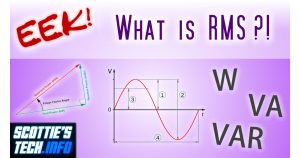 You probably do this all the time, but you don’t even know it.
You probably do this all the time, but you don’t even know it.
I’m talking about AC power calculations with P = V x I.
Technically, it works. But when you think about it, it shouldn’t. AC has constantly changing voltage and current over time – unlike DC.
So how on earth does it work?
Well, the short version is: RMS, or root mean square!
(more…)
27 September 2017 | Do-It-Yourself, Gizmos, Video |
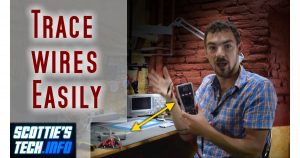 There are many ways to trace a bunch of wires from point A to point B. Most of them kinda suck for one reason or another.
There are many ways to trace a bunch of wires from point A to point B. Most of them kinda suck for one reason or another.
Enter the Voltcraft LZG-1 / Extech CT40!
With this gizmo, you can trace up to 16 wires at once. The system uses a remote unit with 17 alligator clips (16 + one for the common/return conductor).
The remote unit sends a 5V pulse width modulated “square” wave to the main unit. Clip 1 is a ~52% duty cycle wave, and Clip 16 is about 98% duty cycle – at 32 Hz. This allows the main unit to distinguish between each wire reliably – as long as the resistance of each wire is less than 30kohms (which is pretty high).
The main unit also doubles as a DMM. Although it’s not the greatest digitial multimeter, it’s good enough for most applications.
(more…)
29 August 2017 | Do-It-Yourself, Energy, Video |
 First, remain calm. Second, watch this video!
First, remain calm. Second, watch this video!
A tripping circuit breaker or GFCI/RCD/differential breaker can be really annoying. It normally doesn’t happen.
When it does, the end result can be that you run around the room with your undies on your head, screaming like a wildperson.
Obviously, if your vacuum cleaner is charred and black and there’s a funny smell in the room, you’ve just figured out why the breaker tripped. But usually, the problem is a bit more subtle than that…
It turns out that with a bit of work, you can often cleverly narrow down the problem to one gizmo and save yourself some money – without setting anything on fire!
Yay!
(more…)
22 August 2017 | EEK!, How Does it Work?, Video |
 I usually see people freak out when they open the door of their circuit breaker panel. No more!
I usually see people freak out when they open the door of their circuit breaker panel. No more!
Note that I’m using European breakers and EU-type panel design as my example, so if you’re in North America or certain other countries, you’re not gonna see the same thing. Still, the general principles are the same.
Also keep in mind that there are far more gizmos that you might find in your panel: combined GFCI/circuit breakers, timers, and even a nifty gizmo that turns off circuit B when circuit A is energized.
Having said all that, if you just need a basic intro to breaker panels of all types, this is a good place to start! Then follow up with a book or an internet search for your specific location, and Bob’s your uncle.
(more…)
24 June 2017 | EEK!, Energy, How Does it Work?, Video |
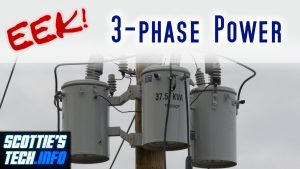 Why does AC electrical power come in 3 phases? What the heck is a “phase”, anyway?
Why does AC electrical power come in 3 phases? What the heck is a “phase”, anyway?
In this episode of the EEK! Series, you’ll learn about 3-phase power and its advantages.
In short: fewer wires, more power, and the Earth itself is a conductor.
In addition, 3-phase industrial motors are more efficient and don’t require a starting capacitor since the 3 phases are “rotating” already.
Be sure to watch EEK! #1 and EEK! #2 first!
(more…)
4 June 2017 | EEK!, Energy, How Does it Work?, Video |
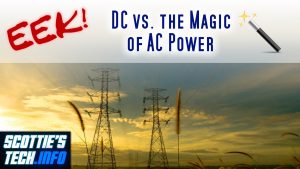 In episode 2 of the EEK! series, we cover the basic difference between direct current (DC) and alternating current (AC). Why is your home powered by AC, and not DC?
In episode 2 of the EEK! series, we cover the basic difference between direct current (DC) and alternating current (AC). Why is your home powered by AC, and not DC?
Simply put, AC allows the use of transformers to step up the voltage, step down the current, and therefore bypass the little problem of too much current flowing over a thin wire.
DC cannot be easily converted in this way for efficient power transmission over long distances. There’s more to say about AC, so look for a 3-phase video soon.
Check out the video below!
(more…)
25 August 2012 | How Does it Work? |
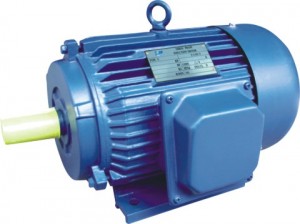 A lot of people wonder how alternating current (AC) induction motors work. In fact, I myself wondered exactly how they worked for a long time.
A lot of people wonder how alternating current (AC) induction motors work. In fact, I myself wondered exactly how they worked for a long time.
You see, I’m an electrical engineer, so I should know these things from my university education.
Unfortunately, in this age of digital everything, power electronics tends to get the shaft in favor of microprocessor design, digital signal processing, and so on. Digital is where the bucks are, you see…
And so, for the longest time, I never actually fully understood how AC induction motors work. DC motors are easy enough to understand, but the AC versions are a bit more complicated. That Tesla was a smart dude (the man, not the car company).
Enter a series of YouTube videos that explain AC motors so well, even a monkey with half a brain could understand it!
(more…)
 While everyone is paying the most attention to wireless tech like 5G, dirty electricity is often completely overlooked.
While everyone is paying the most attention to wireless tech like 5G, dirty electricity is often completely overlooked.







 A lot of people wonder how alternating current (AC) induction motors work. In fact, I myself wondered exactly how they worked for a long time.
A lot of people wonder how alternating current (AC) induction motors work. In fact, I myself wondered exactly how they worked for a long time.
Recent Comments